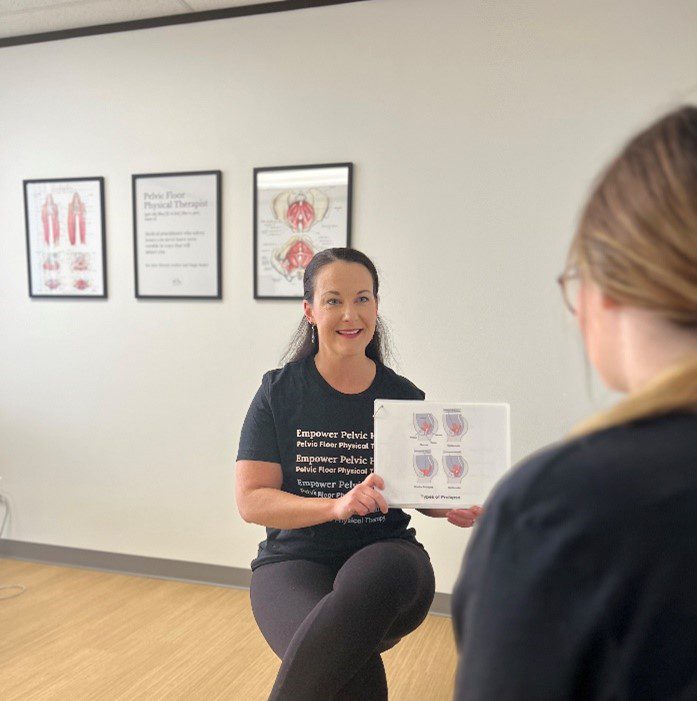
This article was written and submitted by Empower Pelvic Health
Prolapse
Let me hit you with an intense fact: 1 in 5 women suffers from pelvic organ prolapse! (Nygaard, 2008). What a staggering number! Next time you are at your kid’s friend’s birthday party, look discreetly around and imagine every fifth woman you see represents someone who has a pelvic floor prolapse. It’s a lot, right? Now think about all women… that’s millions of women worldwide!
What is pelvic organ prolapse?
Pelvic organ prolapse (POP) is the descent of the bladder, cervix, or rectum into the vaginal canal due to a lack of support from the pelvic floor muscles and other pelvic structures. Everyone (yes, even men!) has layers of muscles that support their pelvic organs. Pelvic floor muscles start at the pubic bone in the front and stretch to the tailbone in the back, functioning like an internal hammock at the base of the pelvis. They are designed to stretch, support, and rebound under stress.
In females, this hammock cradles the bladder, the uterus, and the rectum.
Pelvic organ prolapse happens when the forces pulling/pushing down (gravity, intraabdominal pressure, etc.) exceed the forces supporting from below (pelvic floor muscles, fascial support, etc.). If these muscles are damaged or weakened, they may be unable to support the organs, which results in the collapse of these organs into or through the vaginal canal walls. (Strauhal, 2016)
Types of pelvic organ prolapse:
No one prolapse is the same, not even in the world of pelvic floor physical therapy. Every woman is unique and can suffer from one or multiple types of prolapse. Here are the different types:
Bladder (Anterior Prolapse/Cystocele) (Bradley, 2014)
A cystocele occurs when the pelvic floor muscles cannot support the pelvic organs, and part of the bladder “falls” into the front wall of the vagina. A cystocele is the most common form of POP.
Rectum (Posterior Prolapse/Rectocele)
A rectocele occurs with the pelvic floor tissue between the rectum and the vagina weakens or thins, and part of the rectum may “fall” into the back wall of the vagina.
Uterus (Apical/Uterine prolapse)
Uterine prolapse occurs with weakened pelvic floor muscles and ligaments. This is when the uterus slides out of place and “falls” into the vaginal canal.

How would I know if I suffer from prolapse?
The most common symptom of prolapse is a feeling of heaviness or pressure in the vagina. Some women even describe this sensation as “sitting on an egg.” This heaviness or pressure typically worsens as the day goes on. Gravity, poor pressure management, and poor posture as the day continues are reasons your prolapse symptoms may worsen throughout the day. Other common symptoms of prolapse are:
- Leaking urine
- Inability to completely void bladder
- Back pressure or pain
- Pain with intercourse
- Feeling of laxity (looseness) within the vagina
- Difficulty reaching orgasm
- Worsening or lead to constipation
- Needing to insert fingers into the vagina to assist with bowel movements (pushing against the walls of the vagina to move stool through the anus)
What should I do if I experience one or more of these symptoms?
The first thing you should do is take a BREATH! Prolapse is not a death sentence. You should seek care from either a board-certified urogynecologist or pelvic floor physical therapy specialist. The urogynecologist will grade or stage your prolapse. Prolapse is graded by:
Stage 1: mild bulge.
Stage 2: moderate bulge that does not go past the entrance of your vagina.
Stage 3: Severe bulge that goes past the entrance of your vagina or seems to fall out.
Stage 4: Significant bulge without the ability to be reduced into the vaginal canal.
Other than Stage 4, POPs can and should be treated conservatively by a pelvic floor physical therapist before surgery is ever considered. Often your stage of prolapse does not match your symptom severity. What does this mean? A mild prolapse can have multiple symptoms and may feel like your organs will fall out of your vagina, while a severe prolapse may only have urinary symptoms.

How can pelvic floor physical therapy help?
A pelvic floor physical therapist will look locally at your pelvic floor and determine the strength, power, coordination, and timing of your pelvic floor muscles. Remember every prolapse is different, and an individual assessment will give the best idea of what is going on with YOUR prolapse. Furthermore, and most importantly, your pelvic floor physical therapist should evaluate your global muscular system and how your entire body functions with your pelvic floor. This is the best way to reduce prolapse symptoms and give you back your quality of life.
For more information contact Empower Pelvic Health or follow them on social media!
